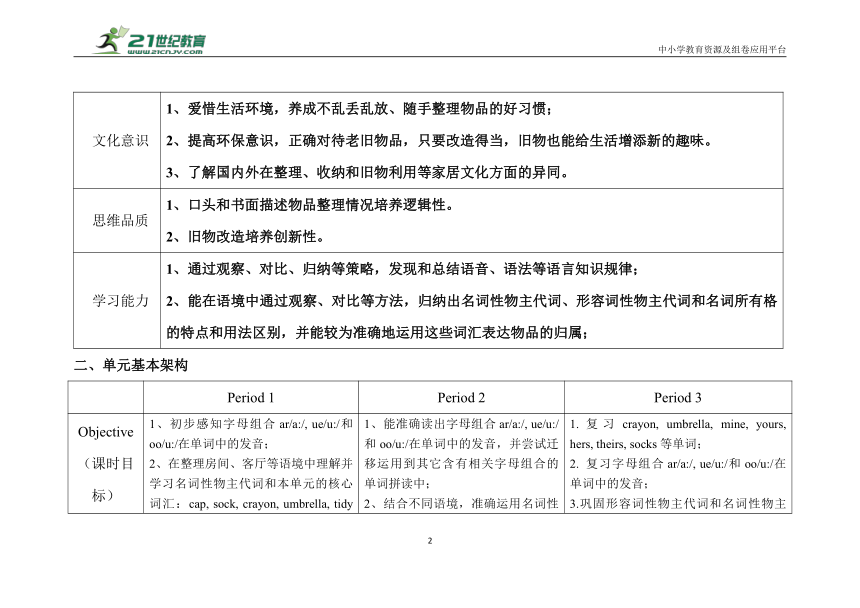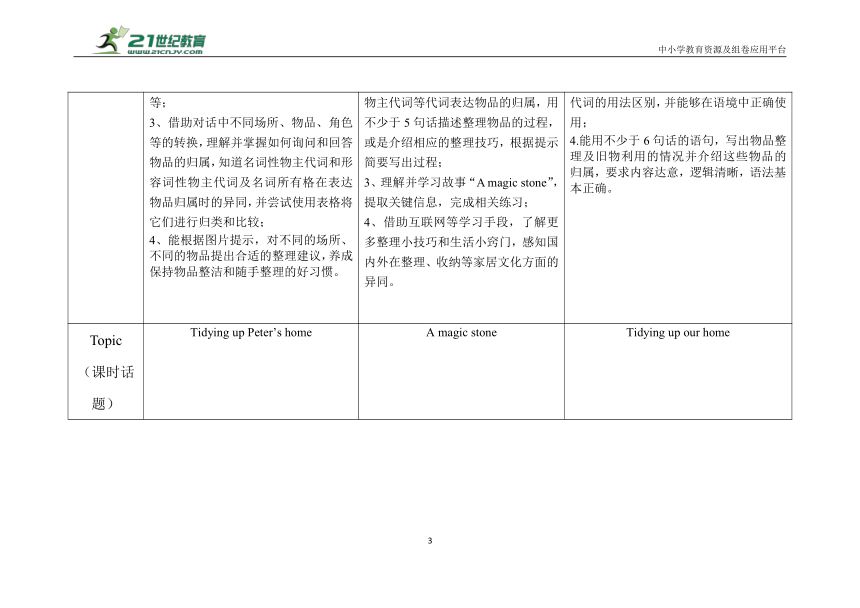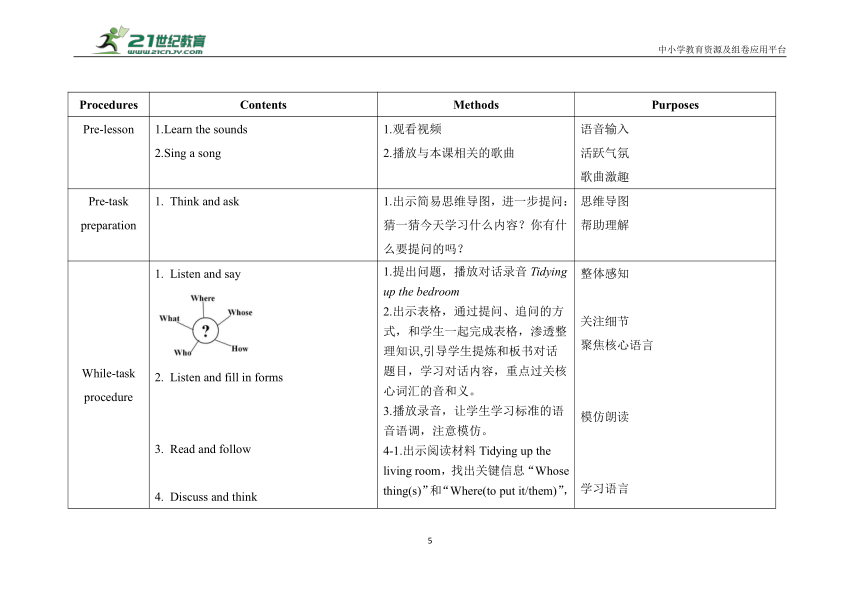牛津深圳五下 Unit 1 Tidy up!单元整体教学设计
文档属性
| 名称 | 牛津深圳五下 Unit 1 Tidy up!单元整体教学设计 |

|
|
| 格式 | docx | ||
| 文件大小 | 887.8KB | ||
| 资源类型 | 试卷 | ||
| 版本资源 | 牛津深圳版 | ||
| 科目 | 英语 | ||
| 更新时间 | 2023-06-08 15:29:20 | ||
图片预览





文档简介
中小学教育资源及组卷应用平台
Teachers’ Unit-based Teaching design
学校: 备课组老师:
Title: 5B Module 1Unit _1__Tidy up! 日期:
一、单元教学目标 (参照2022版课标中的分级标准描述)
语用任务:口头及书面描述物品整理的过程及介绍物品归属,要求6-8句话,内容达意,逻辑清晰,语法基本正确。
语言能力 1.理解并学习本单元的核心词汇:mine, yours, hers, theirs, tidy, cap, sock, crayon, umbrella等,并能在恰当的语境中运用这些词汇; 2.能听懂和读懂询问物品归属的对话,能用一般疑问句以及“Whose … is this/are those ”等句型询问物品归属,并能用“It’s/They’re …”准确回答出物品的主人; 3.学习字母组合ar/a:/, ue/u:/和oo/u:/在单词中的发音,能正确拼读相关单词,并能将读音规则迁移运用到其它含有相关字母组合的单词拼读中;
文化意识 1、爱惜生活环境,养成不乱丢乱放、随手整理物品的好习惯; 2、提高环保意识,正确对待老旧物品,只要改造得当,旧物也能给生活增添新的趣味。 3、了解国内外在整理、收纳和旧物利用等家居文化方面的异同。
思维品质 口头和书面描述物品整理情况培养逻辑性。 2、旧物改造培养创新性。
学习能力 1、通过观察、对比、归纳等策略,发现和总结语音、语法等语言知识规律; 2、能在语境中通过观察、对比等方法,归纳出名词性物主代词、形容词性物主代词和名词所有格的特点和用法区别,并能较为准确地运用这些词汇表达物品的归属;
二、单元基本架构
Period 1 Period 2 Period 3
Objective (课时目标) 1、初步感知字母组合ar/a:/, ue/u:/和oo/u:/在单词中的发音; 2、在整理房间、客厅等语境中理解并学习名词性物主代词和本单元的核心词汇:cap, sock, crayon, umbrella, tidy等; 3、借助对话中不同场所、物品、角色等的转换,理解并掌握如何询问和回答物品的归属,知道名词性物主代词和形容词性物主代词及名词所有格在表达物品归属时的异同,并尝试使用表格将它们进行归类和比较; 4、能根据图片提示,对不同的场所、不同的物品提出合适的整理建议,养成保持物品整洁和随手整理的好习惯。 1、能准确读出字母组合ar/a:/, ue/u:/和oo/u:/在单词中的发音,并尝试迁移运用到其它含有相关字母组合的单词拼读中; 2、结合不同语境,准确运用名词性物主代词等代词表达物品的归属,用不少于5句话描述整理物品的过程,或是介绍相应的整理技巧,根据提示简要写出过程; 3、理解并学习故事“A magic stone”,提取关键信息,完成相关练习; 4、借助互联网等学习手段,了解更多整理小技巧和生活小窍门,感知国内外在整理、收纳等家居文化方面的异同。 复习crayon, umbrella, mine, yours, hers, theirs, socks等单词; 复习字母组合ar/a:/, ue/u:/和oo/u:/在单词中的发音; 3.巩固形容词性物主代词和名词性物主代词的用法区别,并能够在语境中正确使用; 4.能用不少于6句话的语句,写出物品整理及旧物利用的情况并介绍这些物品的归属,要求内容达意,逻辑清晰,语法基本正确。
Topic (课时话题) Tidying up Peter’s home A magic stone Tidying up our home
Content (教学文本) Listen and say Look and learn Learn the sounds Read a story Learn the sounds Think and write revision
Blackboard design (板书设计)
三、单课教学设计
Period 1
Procedures Contents Methods Purposes
Pre-lesson 1.Learn the sounds 2.Sing a song 1.观看视频 2.播放与本课相关的歌曲 语音输入 活跃气氛 歌曲激趣
Pre-task preparation Think and ask 1.出示简易思维导图,进一步提问:猜一猜今天学习什么内容?你有什么要提问的吗? 思维导图 帮助理解
While-task procedure Listen and say Listen and fill in forms Read and follow Discuss and think 1.提出问题,播放对话录音Tidying up the bedroom 2.出示表格,通过提问、追问的方式,和学生一起完成表格,渗透整理知识,引导学生提炼和板书对话题目,学习对话内容,重点过关核心词汇的音和义。 3.播放录音,让学生学习标准的语音语调,注意模仿。 4-1.出示阅读材料Tidying up the living room,找出关键信息“Whose thing(s)”和“Where(to put it/them)”,及时板书。 4-2.再次出示物主代词表格,引导学生根据自己的理解填入相应位置并观察差异,出示两者使用规则的口诀。 整体感知 关注细节 聚焦核心语言 模仿朗读 学习语言 借助表格 口诀记忆
Post-task activities Choose and say Retelling Think and rewrite Summary and review 1.出示不同的人物和不同的物品,让学生选择合适的词补全句子。 2.引导学生结合板书,使用陈述性语言进行复述: Sally and Peter are tidying up ____ bedroom. Paul’s ___ and ___ are on the floor. Peter puts them on his bed. The ___ on the desk is Peter’s. Maybe he needs to put it in/on the ___. Now, the room is clean and tidy. 3.以Tidying up 为题目,给出框架,让学生用陈述性语言对今天所学内容进行改写。 4.及时梳理所学知识,突出本课的重点,加强学法指导,为下一课时突破难点作铺垫。 笔头练习 加强理解和记忆 促进思考 语境带动 综合语用输出 叙述角度的不同引起人称变化 板书复习 顺清课堂 培养思维
Assignment 1.朗读今天学习的对话,注意情感和语音。 2. 阅读三个小故事,完成每个故事后面的5道小题,并找出里面含有字母组合ar/a:/, ue/u:/和oo/u:/的单词。 3.除了卧室和客厅,家里还有什么地方需要经常整理吗?你通常是怎么整理的?请认真思考,下一节课积极分享。
Period 2
Procedures Contents Methods Purposes
Pre-lesson Homework-checking 1.检查作业,了解上节课重点内容的掌握情况。 作业检查 掌握情况
Pre-task preparation Revision 1-1检查从语音故事中找出的含字母组合ar/a:/, ue/u:/和oo/u:/的单词,学生尝试总结发音规律。 1-2出示一些教室里物品凌乱堆放的图片,给出部分提示,引导学生说出自己的建议或做法。 检查语用输出 巩固旧知 预热新知
While-task procedure Look and say Watch and answer 2.Watch and ask 3-1 Picture-touring 3-2 Put sentences in order 3-3 Follow the recording and repeat 出示一些物品凌乱摆放的图片,让学生直观感受物品整理的必要性。 播放视频“Tidying up”,引导学生思考视频内不同角色的不同整理方法是否合理。 2.播放故事A magic stone的视频两遍,出示常用的特殊疑问词,鼓励学生就故事内容提出问题: Who… What… Whose… How… 3-1.逐一出示故事图片,与学生就内容细节问答,然后让学生简单描述整幅图。 3-2.重点学习第4幅图,出示表示顺序的副词first, then, finally,让学生直观感受磁铁收纳钉子的过程。 3-3.播放视频让学生跟读。 新知设疑 学习故事 思维发散 分层教学 整体感知 分段研学
Post-task activity Retelling Rewrite the story based on the story outline and frame 2.Discuss and think 3.Watch and say 4. Summary and review 1-1.给出图片和关键词,让学生复述故事。 1-2.提供故事框架,让学生改写故事。 2.讨论总结magnet在整理收纳中所起的作用,让学生思考它还有哪些用处? 3.播放收纳达人等视频,学习更多的收纳技巧。 4-1.回看上节课的语音阅读作业,用思维导图将其进行分类: 4-2.将学到的整理方法进行分类: 1)按场所;2)按体积大小;3)按便捷程度等。 掌握故事内容 学习收纳技巧 联系生活实际 思考出更多方法 借助网络 取长补短 自主小结 树立学法意识
Assignment 1.模仿跟读故事A magic stone,注意语音语调。 2.完成《活动手册》P2-5。 3.你在日常整理和收纳过程中,除了会遇到方法或技巧上的问题,还有可能会遇到什么问题?想一想,下一节课交流。
Period 3
Procedures Contents Methods Purposes
Pre-lesson 1.Revision 1.复习字母组合ar/a:/, ue/u:/和oo/u:/的发音规律,并拓展相关单词。 复习语音
Pre-task preparation Lead in Show a messy room of mine, then lead in the title. T: Whose...is this/that S1: It’s…’s. T: Is it yours/his/hers… S1: Yes. /No. It’s…T: Please put the… S1: Ok. T: Whose…are these/are those S2: They’re… T: Are they 复习巩固
While-task procedure 1.Look and say 2.Complete the chart 3.Pair work 1、Show some pictures T:(show a picture of an umbrella) What’s this S1:It’s an umbrella. T:(stick the picture on the blackboard) Umbrella, an umbrella. Ss::Umbrella, an umbrella. T:(point to the picture) Whose umbrella is this S2:It’s Ben’s. T:This umbrella is Ben’s. It’s his. Ss::This umbrella is Ben’s. It’s his. And then review crayon. Look at the pictures and try to complete the chart. 3、Try to talk to partners S1:Are the crayons Alice’s S2:No, they are not hers. S1:Whose crayons are these S2::They are Jill’s. S3:Is the schoolbag Joe’s S4:No, it’s not his. 图片输入 获取信息 对话练习 巩固操练
Post-task activity 1.Think and say 2.Think and write 学生根据老师给的图片分从Whose,Where, What, How等关键词对房间进行描述。 根据前面铺垫,完成写作任务。 归纳总结 搭建框架 综合语用 写作输出
Assignment Talk about your room Draw a picture and write a text about your new room.
注:1-4年级按3课时,5-6年级可根据内容按4课时编写。
教学设计说明 (800字左右)
本年级下册第1模块Changes and differences介绍的是生活中的各种变化,本单元是其中的第1单元,围绕着“Tidy up”(整理物品)给生活带来变化这一话题展开学习,并将名词性物主代词这个难懂语法知识点融入到语境中去学习,让学生在学习整理物品的对话中去理解和运用相关词汇。名词性物主代词在小学阶段属于首次出现,又是一个重点和难点,此类词汇通常也不会孤立存在,而是常与以前学习过的形容词性物主代词或名词所有格一起出现在对话、短文等学习内容中,共同完成表达物品归属的功能,然而,在核心栏目Listen and say的对话中,只出现了Peter和Sally两个主要人物和一个不露面的Paul,如此单薄的人设不足以完成名词性物主代词的学习任务,而且对话的场景发生在卧室里,所涉及到的物品也很有限,现实生活中需要整理物品场所,除了卧室以外,客厅、厨房、教室等地也经常需要学生参与收拾和整理,在这过程中可能会涉及到的物品种类也是多种多样的,如,衣物、玩具、学习用品、生活用品等。
基于五年级学生的实际学情及教材的有限性,为了让学生充分体验语言知识的丰富性和学习语境的多样性,及时完善教材内容的不足之处,本单元设计将教材内容进行合理调整和适当补充,让学生在整理物品、发现整理小窍门、旧物改造和利用等不同的语境中感受、体验和运用名词性物主代词等新学语言知识,采用循序渐进的操练和实践活动,逐步提升其语言综合运用能力,充分体现新课程标准所倡导的“通过体验、实践、参与、探究和合作等方式,发现语言规律,逐步掌握语言知识和技能”的学习理念。除了Listen and say和Read a story里的文本内容以外,还补充文本,辅以视频、图片、实物等多种教学素材,让学生在不同的语境中理解和学习名词性物主代词等语言知识的同时,也能够学习到更多整理物品的方法和旧物利用的小窍门,多方位体验“Tidy up”给生活带来的“Changes and differences”。在语言操练方面,采用循序渐进的操练和实践活动,逐步提升其语言综合运用能力,充分体现新课程标准所倡导的“通过体验、实践、参与、探究和合作等方式,发现语言规律,逐步掌握语言知识和技能”的学习理念。
五、单元综合评价
I. 短文填空 (单词和短语)
Jimmy sees a _____ on the table. It is full of _______. Jimmy ______ the nails. All the nails _______the floor. Jimmy’s father gives him a ______________. Jimmy _____ the stone ______the nails. The nails all _________ it. In a few seconds, the floor is ________ again.
II. 语音判断(或语音选择)
请在句子中找出一个与例词划线部分读音相同的单词。
例如:(driver) pilot Sally will be a taxi driver in 10 years.
( ) 1. school I have a blue book.
( ) 2. car Peter goes to the park by bike.
( ) 3. skirt She cannot find her purse.
( ) 4. bee A beautiful deer is having tea.
( ) 5. floor Open the door, please.
III.阅读理解(请注明出处)
A
Learning how to sew
Louise is learning how to sew. Her teacher is Mrs. Pringle. Mrs. Pringle is showing Louise how to use a sewing machine. She shows Louise how to put the thread in the sewing machine. She shows her how to sew in a straight line. It is not easy. Louise practices with the small sewing machine. She carefully sews an old piece of fabric. She practices until she can use the sewing machine by herself.
Now Louise can use the big sewing machine. She is sewing a piece of white fabric. She is making a skirt. Louise wants to make lots of clothes for herself.
根据短文内容判断,相符的写“A”,不相符的写“B”
( )1. Louise is showing Mrs. Pringle how to use a sewing machine.
( )2. Mrs. Pringle shows Louise how to sew in a triangle.
( )3. Louise sews an old piece of fabric carefully.
( )4. Louise wants to make a lot of clothes for Mrs. Pringle.
( )5. Louise still cannot use the big sewing machine.
B
Tim is very good at school. He can do everything very well and his teachers like him very much. But at home, Tim is not clean. He often throws the rubbish on the floor. His bedroom is very messy. There are books, toys and clothes on the floor or under his bed. One day, his teacher Miss Guo goes to see him. She looks at him and says,“Tim, I know you can do everything well.But why don't you tidy your bedroom up All of us like a clean boy. I think you are the best.”Tim's face turns red at Miss Guo's words. He begins to tidy his bedroom. After ten minutes, his bedroom becomes tidy and clean.
( )1.-How is Tim at school -He is_____.
A.lazy
B.bad
C.good
( )2.-How is Tim at home -He is_____.
A.lazy
B.good
C.clean
( )3.-Does Tim throw rubbish on the floor at home -_____
A. No, he doesn't.
B.Yes,he does.
C.He throws rubbish in the bin.
( )4.-Who comes to see Tim -That's his_____
A.teacher
B.uncle
C.aunt
( )5.-How does Tim feel when he hears Miss Guo's words -He's_____
A.happy
B.ashamed
C.angry
C
请你读一读,判断下面的句子是否正确,正确的写T(Tue) ,错误的写F(False)。
Baby Bear has a lot of toys.He always puts them everywhere in the room.Mama
Bear is angry, so she wants to throw all the toys away. Baby Bear is worried. He really loves his toys.
Papa Bear calls a family meeting."It isn’t fair to your mama and me,because we have a lot of other things to take care of. And it isn’t fair to you,because you really can’t have fun in a messy(凌乱的)room,”he says.“But Mama is putting all my things into that box! She will throw them away,"says Baby Bear.
Papa Bear has an idea."Yes!Boxes!"he says,"A big box for large toys and some small boxes for small toys.”“Great idea!”says Mama Bear..
Papa Bear makes different kinds of boxes. Some are big and some are small. Baby
Bear and Mama Bear sort(把…分类)the toys and put them into the boxes..“We finished(完成了)!”says Baby Bear,“That was quite a job,but it was worth(值得)it!”
Baby Bear's room is always tidy.( )
Mama Bear is angry with Baby Bear.She wants to throw his toys away.( )
Papa Bear has an idea about how to deal with(处理)those toys.( )
Papa Bear only makes a big box.( )
Baby Bear and Mama Bear sort the toys and put them into the boxes.( )
IV.书面表达
放学了,请帮值日生“物归原主”吧: 写一写是谁的物品在什么位置,并给他们提出整理物品的建议,标题:Tidying up the classroom, 50个单词左右。
参考句型:Look at our classroom. It’s in a mess. There is.... It’s...We can put it ....
V、“窄式阅读”之课外拓展
1.渗透如何整理房间的动画片Tidying up;
2.布克听听系列绘本之:Lulu Packed Her Suitcase
答案:I:box, nails, drops, fall on, black stone, puts, near, stick to , clean.
II:1. blue 2. park 3. purse 4. tea 5. door
16
Teachers’ Unit-based Teaching design
学校: 备课组老师:
Title: 5B Module 1Unit _1__Tidy up! 日期:
一、单元教学目标 (参照2022版课标中的分级标准描述)
语用任务:口头及书面描述物品整理的过程及介绍物品归属,要求6-8句话,内容达意,逻辑清晰,语法基本正确。
语言能力 1.理解并学习本单元的核心词汇:mine, yours, hers, theirs, tidy, cap, sock, crayon, umbrella等,并能在恰当的语境中运用这些词汇; 2.能听懂和读懂询问物品归属的对话,能用一般疑问句以及“Whose … is this/are those ”等句型询问物品归属,并能用“It’s/They’re …”准确回答出物品的主人; 3.学习字母组合ar/a:/, ue/u:/和oo/u:/在单词中的发音,能正确拼读相关单词,并能将读音规则迁移运用到其它含有相关字母组合的单词拼读中;
文化意识 1、爱惜生活环境,养成不乱丢乱放、随手整理物品的好习惯; 2、提高环保意识,正确对待老旧物品,只要改造得当,旧物也能给生活增添新的趣味。 3、了解国内外在整理、收纳和旧物利用等家居文化方面的异同。
思维品质 口头和书面描述物品整理情况培养逻辑性。 2、旧物改造培养创新性。
学习能力 1、通过观察、对比、归纳等策略,发现和总结语音、语法等语言知识规律; 2、能在语境中通过观察、对比等方法,归纳出名词性物主代词、形容词性物主代词和名词所有格的特点和用法区别,并能较为准确地运用这些词汇表达物品的归属;
二、单元基本架构
Period 1 Period 2 Period 3
Objective (课时目标) 1、初步感知字母组合ar/a:/, ue/u:/和oo/u:/在单词中的发音; 2、在整理房间、客厅等语境中理解并学习名词性物主代词和本单元的核心词汇:cap, sock, crayon, umbrella, tidy等; 3、借助对话中不同场所、物品、角色等的转换,理解并掌握如何询问和回答物品的归属,知道名词性物主代词和形容词性物主代词及名词所有格在表达物品归属时的异同,并尝试使用表格将它们进行归类和比较; 4、能根据图片提示,对不同的场所、不同的物品提出合适的整理建议,养成保持物品整洁和随手整理的好习惯。 1、能准确读出字母组合ar/a:/, ue/u:/和oo/u:/在单词中的发音,并尝试迁移运用到其它含有相关字母组合的单词拼读中; 2、结合不同语境,准确运用名词性物主代词等代词表达物品的归属,用不少于5句话描述整理物品的过程,或是介绍相应的整理技巧,根据提示简要写出过程; 3、理解并学习故事“A magic stone”,提取关键信息,完成相关练习; 4、借助互联网等学习手段,了解更多整理小技巧和生活小窍门,感知国内外在整理、收纳等家居文化方面的异同。 复习crayon, umbrella, mine, yours, hers, theirs, socks等单词; 复习字母组合ar/a:/, ue/u:/和oo/u:/在单词中的发音; 3.巩固形容词性物主代词和名词性物主代词的用法区别,并能够在语境中正确使用; 4.能用不少于6句话的语句,写出物品整理及旧物利用的情况并介绍这些物品的归属,要求内容达意,逻辑清晰,语法基本正确。
Topic (课时话题) Tidying up Peter’s home A magic stone Tidying up our home
Content (教学文本) Listen and say Look and learn Learn the sounds Read a story Learn the sounds Think and write revision
Blackboard design (板书设计)
三、单课教学设计
Period 1
Procedures Contents Methods Purposes
Pre-lesson 1.Learn the sounds 2.Sing a song 1.观看视频 2.播放与本课相关的歌曲 语音输入 活跃气氛 歌曲激趣
Pre-task preparation Think and ask 1.出示简易思维导图,进一步提问:猜一猜今天学习什么内容?你有什么要提问的吗? 思维导图 帮助理解
While-task procedure Listen and say Listen and fill in forms Read and follow Discuss and think 1.提出问题,播放对话录音Tidying up the bedroom 2.出示表格,通过提问、追问的方式,和学生一起完成表格,渗透整理知识,引导学生提炼和板书对话题目,学习对话内容,重点过关核心词汇的音和义。 3.播放录音,让学生学习标准的语音语调,注意模仿。 4-1.出示阅读材料Tidying up the living room,找出关键信息“Whose thing(s)”和“Where(to put it/them)”,及时板书。 4-2.再次出示物主代词表格,引导学生根据自己的理解填入相应位置并观察差异,出示两者使用规则的口诀。 整体感知 关注细节 聚焦核心语言 模仿朗读 学习语言 借助表格 口诀记忆
Post-task activities Choose and say Retelling Think and rewrite Summary and review 1.出示不同的人物和不同的物品,让学生选择合适的词补全句子。 2.引导学生结合板书,使用陈述性语言进行复述: Sally and Peter are tidying up ____ bedroom. Paul’s ___ and ___ are on the floor. Peter puts them on his bed. The ___ on the desk is Peter’s. Maybe he needs to put it in/on the ___. Now, the room is clean and tidy. 3.以Tidying up 为题目,给出框架,让学生用陈述性语言对今天所学内容进行改写。 4.及时梳理所学知识,突出本课的重点,加强学法指导,为下一课时突破难点作铺垫。 笔头练习 加强理解和记忆 促进思考 语境带动 综合语用输出 叙述角度的不同引起人称变化 板书复习 顺清课堂 培养思维
Assignment 1.朗读今天学习的对话,注意情感和语音。 2. 阅读三个小故事,完成每个故事后面的5道小题,并找出里面含有字母组合ar/a:/, ue/u:/和oo/u:/的单词。 3.除了卧室和客厅,家里还有什么地方需要经常整理吗?你通常是怎么整理的?请认真思考,下一节课积极分享。
Period 2
Procedures Contents Methods Purposes
Pre-lesson Homework-checking 1.检查作业,了解上节课重点内容的掌握情况。 作业检查 掌握情况
Pre-task preparation Revision 1-1检查从语音故事中找出的含字母组合ar/a:/, ue/u:/和oo/u:/的单词,学生尝试总结发音规律。 1-2出示一些教室里物品凌乱堆放的图片,给出部分提示,引导学生说出自己的建议或做法。 检查语用输出 巩固旧知 预热新知
While-task procedure Look and say Watch and answer 2.Watch and ask 3-1 Picture-touring 3-2 Put sentences in order 3-3 Follow the recording and repeat 出示一些物品凌乱摆放的图片,让学生直观感受物品整理的必要性。 播放视频“Tidying up”,引导学生思考视频内不同角色的不同整理方法是否合理。 2.播放故事A magic stone的视频两遍,出示常用的特殊疑问词,鼓励学生就故事内容提出问题: Who… What… Whose… How… 3-1.逐一出示故事图片,与学生就内容细节问答,然后让学生简单描述整幅图。 3-2.重点学习第4幅图,出示表示顺序的副词first, then, finally,让学生直观感受磁铁收纳钉子的过程。 3-3.播放视频让学生跟读。 新知设疑 学习故事 思维发散 分层教学 整体感知 分段研学
Post-task activity Retelling Rewrite the story based on the story outline and frame 2.Discuss and think 3.Watch and say 4. Summary and review 1-1.给出图片和关键词,让学生复述故事。 1-2.提供故事框架,让学生改写故事。 2.讨论总结magnet在整理收纳中所起的作用,让学生思考它还有哪些用处? 3.播放收纳达人等视频,学习更多的收纳技巧。 4-1.回看上节课的语音阅读作业,用思维导图将其进行分类: 4-2.将学到的整理方法进行分类: 1)按场所;2)按体积大小;3)按便捷程度等。 掌握故事内容 学习收纳技巧 联系生活实际 思考出更多方法 借助网络 取长补短 自主小结 树立学法意识
Assignment 1.模仿跟读故事A magic stone,注意语音语调。 2.完成《活动手册》P2-5。 3.你在日常整理和收纳过程中,除了会遇到方法或技巧上的问题,还有可能会遇到什么问题?想一想,下一节课交流。
Period 3
Procedures Contents Methods Purposes
Pre-lesson 1.Revision 1.复习字母组合ar/a:/, ue/u:/和oo/u:/的发音规律,并拓展相关单词。 复习语音
Pre-task preparation Lead in Show a messy room of mine, then lead in the title. T: Whose...is this/that S1: It’s…’s. T: Is it yours/his/hers… S1: Yes. /No. It’s…T: Please put the… S1: Ok. T: Whose…are these/are those S2: They’re… T: Are they 复习巩固
While-task procedure 1.Look and say 2.Complete the chart 3.Pair work 1、Show some pictures T:(show a picture of an umbrella) What’s this S1:It’s an umbrella. T:(stick the picture on the blackboard) Umbrella, an umbrella. Ss::Umbrella, an umbrella. T:(point to the picture) Whose umbrella is this S2:It’s Ben’s. T:This umbrella is Ben’s. It’s his. Ss::This umbrella is Ben’s. It’s his. And then review crayon. Look at the pictures and try to complete the chart. 3、Try to talk to partners S1:Are the crayons Alice’s S2:No, they are not hers. S1:Whose crayons are these S2::They are Jill’s. S3:Is the schoolbag Joe’s S4:No, it’s not his. 图片输入 获取信息 对话练习 巩固操练
Post-task activity 1.Think and say 2.Think and write 学生根据老师给的图片分从Whose,Where, What, How等关键词对房间进行描述。 根据前面铺垫,完成写作任务。 归纳总结 搭建框架 综合语用 写作输出
Assignment Talk about your room Draw a picture and write a text about your new room.
注:1-4年级按3课时,5-6年级可根据内容按4课时编写。
教学设计说明 (800字左右)
本年级下册第1模块Changes and differences介绍的是生活中的各种变化,本单元是其中的第1单元,围绕着“Tidy up”(整理物品)给生活带来变化这一话题展开学习,并将名词性物主代词这个难懂语法知识点融入到语境中去学习,让学生在学习整理物品的对话中去理解和运用相关词汇。名词性物主代词在小学阶段属于首次出现,又是一个重点和难点,此类词汇通常也不会孤立存在,而是常与以前学习过的形容词性物主代词或名词所有格一起出现在对话、短文等学习内容中,共同完成表达物品归属的功能,然而,在核心栏目Listen and say的对话中,只出现了Peter和Sally两个主要人物和一个不露面的Paul,如此单薄的人设不足以完成名词性物主代词的学习任务,而且对话的场景发生在卧室里,所涉及到的物品也很有限,现实生活中需要整理物品场所,除了卧室以外,客厅、厨房、教室等地也经常需要学生参与收拾和整理,在这过程中可能会涉及到的物品种类也是多种多样的,如,衣物、玩具、学习用品、生活用品等。
基于五年级学生的实际学情及教材的有限性,为了让学生充分体验语言知识的丰富性和学习语境的多样性,及时完善教材内容的不足之处,本单元设计将教材内容进行合理调整和适当补充,让学生在整理物品、发现整理小窍门、旧物改造和利用等不同的语境中感受、体验和运用名词性物主代词等新学语言知识,采用循序渐进的操练和实践活动,逐步提升其语言综合运用能力,充分体现新课程标准所倡导的“通过体验、实践、参与、探究和合作等方式,发现语言规律,逐步掌握语言知识和技能”的学习理念。除了Listen and say和Read a story里的文本内容以外,还补充文本,辅以视频、图片、实物等多种教学素材,让学生在不同的语境中理解和学习名词性物主代词等语言知识的同时,也能够学习到更多整理物品的方法和旧物利用的小窍门,多方位体验“Tidy up”给生活带来的“Changes and differences”。在语言操练方面,采用循序渐进的操练和实践活动,逐步提升其语言综合运用能力,充分体现新课程标准所倡导的“通过体验、实践、参与、探究和合作等方式,发现语言规律,逐步掌握语言知识和技能”的学习理念。
五、单元综合评价
I. 短文填空 (单词和短语)
Jimmy sees a _____ on the table. It is full of _______. Jimmy ______ the nails. All the nails _______the floor. Jimmy’s father gives him a ______________. Jimmy _____ the stone ______the nails. The nails all _________ it. In a few seconds, the floor is ________ again.
II. 语音判断(或语音选择)
请在句子中找出一个与例词划线部分读音相同的单词。
例如:(driver) pilot Sally will be a taxi driver in 10 years.
( ) 1. school I have a blue book.
( ) 2. car Peter goes to the park by bike.
( ) 3. skirt She cannot find her purse.
( ) 4. bee A beautiful deer is having tea.
( ) 5. floor Open the door, please.
III.阅读理解(请注明出处)
A
Learning how to sew
Louise is learning how to sew. Her teacher is Mrs. Pringle. Mrs. Pringle is showing Louise how to use a sewing machine. She shows Louise how to put the thread in the sewing machine. She shows her how to sew in a straight line. It is not easy. Louise practices with the small sewing machine. She carefully sews an old piece of fabric. She practices until she can use the sewing machine by herself.
Now Louise can use the big sewing machine. She is sewing a piece of white fabric. She is making a skirt. Louise wants to make lots of clothes for herself.
根据短文内容判断,相符的写“A”,不相符的写“B”
( )1. Louise is showing Mrs. Pringle how to use a sewing machine.
( )2. Mrs. Pringle shows Louise how to sew in a triangle.
( )3. Louise sews an old piece of fabric carefully.
( )4. Louise wants to make a lot of clothes for Mrs. Pringle.
( )5. Louise still cannot use the big sewing machine.
B
Tim is very good at school. He can do everything very well and his teachers like him very much. But at home, Tim is not clean. He often throws the rubbish on the floor. His bedroom is very messy. There are books, toys and clothes on the floor or under his bed. One day, his teacher Miss Guo goes to see him. She looks at him and says,“Tim, I know you can do everything well.But why don't you tidy your bedroom up All of us like a clean boy. I think you are the best.”Tim's face turns red at Miss Guo's words. He begins to tidy his bedroom. After ten minutes, his bedroom becomes tidy and clean.
( )1.-How is Tim at school -He is_____.
A.lazy
B.bad
C.good
( )2.-How is Tim at home -He is_____.
A.lazy
B.good
C.clean
( )3.-Does Tim throw rubbish on the floor at home -_____
A. No, he doesn't.
B.Yes,he does.
C.He throws rubbish in the bin.
( )4.-Who comes to see Tim -That's his_____
A.teacher
B.uncle
C.aunt
( )5.-How does Tim feel when he hears Miss Guo's words -He's_____
A.happy
B.ashamed
C.angry
C
请你读一读,判断下面的句子是否正确,正确的写T(Tue) ,错误的写F(False)。
Baby Bear has a lot of toys.He always puts them everywhere in the room.Mama
Bear is angry, so she wants to throw all the toys away. Baby Bear is worried. He really loves his toys.
Papa Bear calls a family meeting."It isn’t fair to your mama and me,because we have a lot of other things to take care of. And it isn’t fair to you,because you really can’t have fun in a messy(凌乱的)room,”he says.“But Mama is putting all my things into that box! She will throw them away,"says Baby Bear.
Papa Bear has an idea."Yes!Boxes!"he says,"A big box for large toys and some small boxes for small toys.”“Great idea!”says Mama Bear..
Papa Bear makes different kinds of boxes. Some are big and some are small. Baby
Bear and Mama Bear sort(把…分类)the toys and put them into the boxes..“We finished(完成了)!”says Baby Bear,“That was quite a job,but it was worth(值得)it!”
Baby Bear's room is always tidy.( )
Mama Bear is angry with Baby Bear.She wants to throw his toys away.( )
Papa Bear has an idea about how to deal with(处理)those toys.( )
Papa Bear only makes a big box.( )
Baby Bear and Mama Bear sort the toys and put them into the boxes.( )
IV.书面表达
放学了,请帮值日生“物归原主”吧: 写一写是谁的物品在什么位置,并给他们提出整理物品的建议,标题:Tidying up the classroom, 50个单词左右。
参考句型:Look at our classroom. It’s in a mess. There is.... It’s...We can put it ....
V、“窄式阅读”之课外拓展
1.渗透如何整理房间的动画片Tidying up;
2.布克听听系列绘本之:Lulu Packed Her Suitcase
答案:I:box, nails, drops, fall on, black stone, puts, near, stick to , clean.
II:1. blue 2. park 3. purse 4. tea 5. door
16
同课章节目录
- Module 1 Changes and differences
- Unit 1 Tidy up!
- Unit 2 Our new home
- Unit 3 In the future
- Revision 1
- Project 1
- Module 2 Work and play
- Unit 4 Reading is fun
- Unit 5 At the weekend
- Unit 6 Holidays
- Revision 2
- Project 2
- Module 3 Things we do
- Unit 7 Open Day
- Unit 8 Buying clothes
- Unit 9 Seeing the docto
- Revision 3
- Project 3
- Module 4 Things we enjoy
- Unit 10 Great inventions
- Unit 11 Chinese festivals
- Unit 12 The giant's garden
- Project 4
